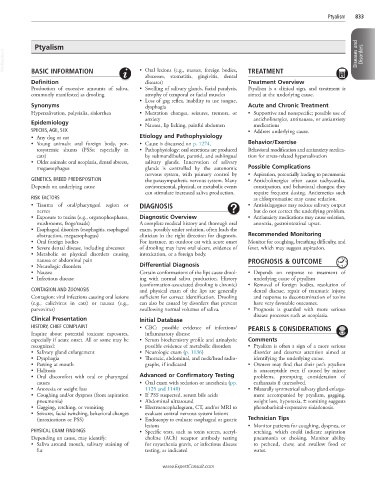Page 1661 - Cote clinical veterinary advisor dogs and cats 4th
P. 1661
Ptyalism 833
Ptyalism
VetBooks.ir Diseases and Disorders
BASIC INFORMATION
• Oral lesions (e.g., masses, foreign bodies,
abscesses, stomatitis, gingivitis, dental TREATMENT
Definition diseases) Treatment Overview
Production of excessive amounts of saliva, • Swelling of salivary glands, facial paralysis, Ptyalism is a clinical sign, and treatment is
commonly manifested as drooling atrophy of temporal or facial muscles aimed at the underlying cause.
• Loss of gag reflex, inability to use tongue,
Synonyms dysphagia Acute and Chronic Treatment
Hypersalivation, polysialia, sialorrhea • Mentation changes, seizures, tremors, or • Supportive and nonspecific; possible use of
anxiety anticholinergics, antinausea, or antianxiety
Epidemiology • Nausea, lip licking, painful abdomen medications
SPECIES, AGE, SEX • Address underlying cause.
• Any dog or cat Etiology and Pathophysiology
• Young animals: oral foreign body, por- • Cause is discussed on p. 1274. Behavior/Exercise
tosystemic shunts (PSSs; especially in • Pathophysiology: oral secretions are produced Behavioral modification and antianxiety medica-
cats) by submandibular, parotid, and sublingual tion for stress-related hypersalivation
• Older animals: oral neoplasia, dental abscess, salivary glands. Innervation of salivary
megaesophagus glands is controlled by the autonomic Possible Complications
nervous system, with primary control by • Aspiration, potentially leading to pneumonia
GENETICS, BREED PREDISPOSITION the parasympathetic nervous system. Many • Anticholinergics often cause tachycardia,
Depends on underlying cause environmental, physical, or metabolic events constipation, and behavioral changes; they
can stimulate increased saliva production. require frequent dosing. Antiemetics such
RISK FACTORS as chlorpromazine may cause sedation.
• Trauma of oral/pharyngeal region or DIAGNOSIS • Antisialagogues may reduce salivary output
nerves but do not correct the underlying problem.
• Exposure to toxins (e.g., organophosphates, Diagnostic Overview • Antianxiety medications may cause sedation,
mushrooms, frogs/toads) A complete medical history and thorough oral anorexia, gastrointestinal upset.
• Esophageal disorders (esophagitis, esophageal exam, possibly under sedation, often leads the
obstruction, megaesophagus) clinician in the right direction for diagnosis. Recommended Monitoring
• Oral foreign bodies For instance, an outdoor cat with acute onset Monitor for coughing, breathing difficulty, and
• Severe dental disease, including abscesses of drooling may have oral ulcers, evidence of fever, which may suggest aspiration.
• Metabolic or physical disorders causing intoxication, or a foreign body.
nausea or abdominal pain PROGNOSIS & OUTCOME
• Neurologic disorders Differential Diagnosis
• Nausea Certain conformations of the lips cause drool- • Depends on response to treatment of
• Infectious disease ing with normal saliva production. History underlying cause of ptyalism
(conformation-associated drooling is chronic) • Removal of foreign bodies, resolution of
CONTAGION AND ZOONOSIS and physical exam of the lips are generally dental disease, repair of traumatic injury,
Contagion: viral infections causing oral lesions sufficient for correct identification. Drooling and response to decontamination of toxins
(e.g., calicivirus in cats) or nausea (e.g., can also be caused by disorders that prevent have very favorable outcomes.
parvovirus) swallowing normal volumes of saliva. • Prognosis is guarded with more serious
disease processes such as neoplasia.
Clinical Presentation Initial Database
HISTORY, CHIEF COMPLAINT • CBC: possible evidence of infectious/ PEARLS & CONSIDERATIONS
Inquire about potential toxicant exposures, inflammatory disease
especially if acute onset. All or some may be • Serum biochemistry profile and urinalysis: Comments
recognized: possible evidence of metabolic disorders • Ptyalism is often a sign of a more serious
• Salivary gland enlargement • Neurologic exam (p. 1136) disorder and deserves attention aimed at
• Dysphagia • Thoracic, abdominal, and neck/head radio- identifying the underlying cause.
• Pawing at mouth graphs, if indicated • Owners may find that their pet’s ptyalism
• Halitosis is unacceptable even if caused by minor
• Oral discomfort with oral or pharyngeal Advanced or Confirmatory Testing problems, prompting consideration of
causes • Oral exam with sedation or anesthesia (pp. euthanasia if unresolved.
• Anorexia or weight loss 1125 and 1140) • Bilaterally symmetrical salivary gland enlarge-
• Coughing and/or dyspnea (from aspiration • If PSS suspected, serum bile acids ment accompanied by ptyalism, gagging,
pneumonia) • Abdominal ultrasound weight loss, hyporexia, ± vomiting suggests
• Gagging, retching, or vomiting • Electroencephalogram, CT, and/or MRI to phenobarbital-responsive sialadenosis.
• Seizures, facial twitching, behavioral changes evaluate central nervous system lesions
(intoxications or PSS) • Endoscopy to evaluate esophageal or gastric Technician Tips
lesions • Monitor patients for coughing, dyspnea, or
PHYSICAL EXAM FINDINGS • Specific tests, such as toxin screen, acetyl- retching, which could indicate aspiration
Depending on cause, may identify: choline (ACh) receptor antibody testing pneumonia or choking. Monitor ability
• Saliva around mouth, salivary staining of for myasthenia gravis, or infectious disease to prehend, chew, and swallow food or
fur testing, as indicated water.
www.ExpertConsult.com

